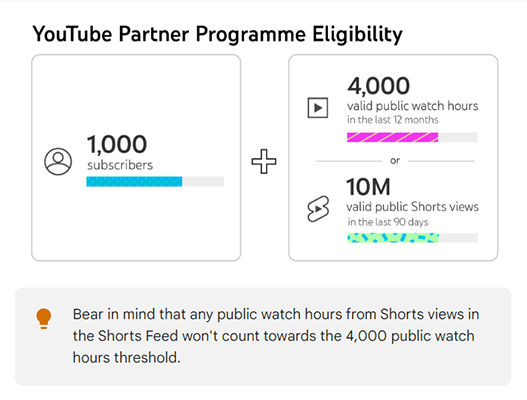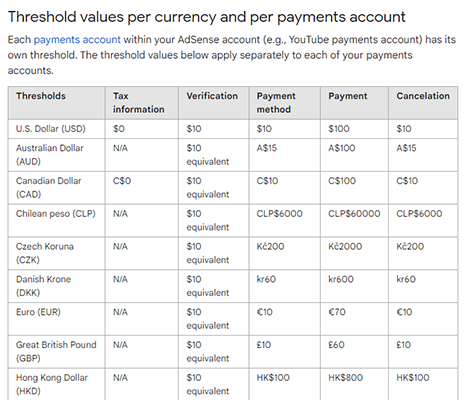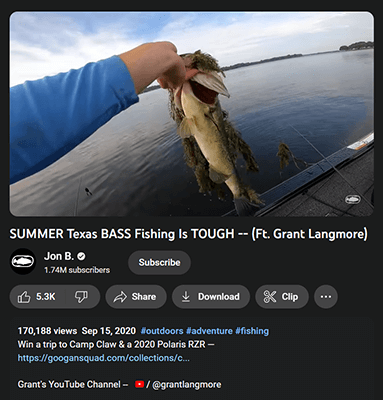Are you interested in learning about how many YouTube views you need to make money on the platform?
YouTube has a lot of sources of revenue, but nothing quite beats the simplicity of uploading YouTube videos and receiving ad revenue from them.
As it turns out, that ad revenue is heavily affected by views.
Let’s see how YouTube views affect your channel’s revenue and how you can increase your views across your entire channel.
How do YouTube views translate into money?
We have a post that covers how many subscribers you need to make money on YouTube.
However, because views have much more influence over your potential to earn revenue on YouTube than subscribers do, we wanted to make a separate post dedicated to the number of views you need to make money on the platform.
Let’s start by discussing how YouTube views translate into money.
We know from our post on how much money YouTubers make that ad revenue accounts for the majority of a YouTuber’s earnings.
YouTubers keep 55% of the ad revenue their videos generate while Google keeps the remaining 45%. Furthermore, creators keep 45% of the ad revenue their content generates from shorts.

But how is ad revenue calculated?
It depends on a few different factors, including niche and where in the world a YouTuber’s audience is located.
The actual amount YouTubers receive from ad revenue is calculated by a simple formula called cost per mile or cost per 1,000 impressions (CPM). This is sometimes referred to as revenue per mile (RPM).
On YouTube, “impressions” means views. Therefore, a YouTuber’s earnings is determined by the amount they make per 1,000 video views.
But like we said, CPM is different among YouTubers and is affected by the creator’s niche and audience location.
How much money do YouTubers make?
In order for YouTubers to start making money on the platform, they need to join the YouTube partner program.
Requirements for the program include having at least 1,000 subscribers and 4,000 watch time hours across your entire YouTube channel. You can also apply if you have 1,000 subscribers and 10 million views from shorts.

With that said, here are real-world figures we collected on the amount YouTubers earn from ad revenue:
- According to Nicole – Generated $9,945.71 in revenue during her first six months of monetization on YouTube. This was generated from 1.13 million views, which puts her CPM at $8.79.
- Rockstar Eater – Generated $5,600.60 from 714,800 views over a 28-day period. This puts his CPM at 7.84.
- Shelby Church – Generated $145,631 from 1.5 million views in 2022. This puts her CPM at $9.64.
We used this data to determine that if you have 1 million subscribers or less and live in the United States, you can expect your CPM to be between $7.84 to $11.37 per 1,000 views.
How many YouTube views do you need to make money?
YouTube will not allow you to start generating revenue from your content until you’re part of the partner program.
Because the partner program requires you to have 4,000 watch time hours, you’re better off focusing your attention on increasing watch time hours at the start of your YouTube career.
You can do this by creating longer videos that are captivating and engaging throughout their duration. Creating videos with longer video lengths is better for ad revenue anyway since these types of videos are able to hold more ads.
Let’s assume you’re already part of the program. What exactly does “making money” mean?
“Making money” on any given social media platform can have a number of different meanings. It could mean earning your first $1 or earning enough to receive a payout.
Let’s talk about the latter option.
YouTube’s minimum threshold for payouts is $100. This means you need to earn at least $100 in revenue in order to transfer your earnings to your bank account.

Because the average YouTube channel receives a CPM between $7.84 and $11.37, we know that creators need to receive between 8,795 and 12,755 views in order to receive their first payout from the platform.
In short, you likely need between 8,000 and 13,000 YouTube views to make money.
But how do you increase your watch time hours so you can start earning revenue faster? How do you receive more views, and what can you do to ensure you receive a higher CPM?
Let’s discuss each of these points.
How to increase your watch time hours on YouTube
“Watch time” is the metric YouTube gives for the amount of time your viewers spend watching your content.
The platform won’t let you apply for the partnership program until you reach 4,000 watch time hours, so your first goal toward monetization should be to reach that milestone.
Essentially, the amount of views you receive doesn’t really matter until you’re able to monetize your content and start earning ad revenue.
One of the simplest ways to increase your watch time is to make longer videos. If your viewers already watch your content from start to finish, give them more to consume.
Unfortunately, making longer videos means holding your viewers’ attention for longer. To do this, you need to get better at storytelling and need to tweak your editing style to encourage viewers to stick around.
Try these tips:
- Use short and quick intros that capture your viewer’s attention and get right to the point.
- Break your videos down into “acts,” even if your videos aren’t scripted or fiction.
- Use pattern interrupters throughout your videos, including different camera angles that shift throughout the video’s duration, text and image overlays, scene changes, background music that changes as acts and scenes change, and b-roll footage.
- Avoid using outro signifiers, such as “if you liked this video, hit that like button, etc.” This lets your viewers know that the video is about to end, and most of them will take off. Use a 10-second outro card with accompanying background music instead.
- Make more evergreen content so that older videos continue accruing watch time.
- Livestream more often, and convert the streams into videos after. The time your viewers spent watching live will count toward your total watch time.
- Create a series that can be built into playlists and binged.
How to get more views on YouTube
Once you’re able to monetize your channel, you need to start bringing in views if you want to make money.
Let’s go over a few surefire tips you can use to increase the amount of views you receive on each and every video you upload to your channel.
This involves two stages: getting viewers interesting enough to click on your videos and capturing their attention well enough to encourage them to stick around.
Let’s talk about how to do both.
How to get YouTube users to click on your videos
Let’s start with the two things YouTube users notice first when they come across your videos: titles and thumbnails.
These are the most prominent aspects of a YouTube video and have been for quite some time.
It’s easy to get into a routine with your titles and thumbnails, especially if you’ve been uploading videos with little to no success for a while.
Try these tips instead:
- Come up with better video concepts. No title or thumbnail can make up for an uninteresting video topic.
- Example: Instead of making a video on “trying Japanese snacks,” put a spin on it, such as “trying convenience store Japanese snacks.”
- Create your own YouTube shows/video series users will recognize as they browse YouTube. Smosh (and their sister channels) is a good example of a channel that creates YouTube shows.
- Use keyword and audience research to determine what topics your audience is searching for in your niche.
- Write better titles. Use numbers whenever possible, emotional triggers and power words.
- Example: “I tried 47 Japanese snacks and hated all but one” instead of simply “trying Japanese snacks.”
- Add keywords to titles. This will increase your chances of having your videos show up in Google search results.
- Add your face to your thumbnails along with an overlay or a few of the video’s subject(s).
- Cross promote your YouTube videos. YouTube lets you add timed, clickable links that lead to other videos on your channel.
- Embed your videos on your website if you have one.
As a bonus suggestion, we advise you to match video length with what your audience expects.
YouTube users can see how long videos are before they click on them. If your video is longer than other videos that cover the same topic, you may find yourself with fewer views than your competitors.
More ways to get your viewers to stick around
We already covered ways to get viewers to stick around in the previous section about increasing your watch time.
We’ll talk about other topics instead.
One of the most effective ways to get viewers to watch your videos for longer is to collaborate with other influencers in your niche.

It doesn’t need to be a popular influencer with millions of followers, either. They just need to have some form of pull in your niche.
One thing we didn’t mention before is the way in which you present content on your channel.
Try and find ways to be a better, more captivating narrator for your videos. Be more lively when you speak, and get better audio equipment if you need to.
How many views do larger YouTubers get?
In our post discussing the amount of money YouTubers make, we included data from a YouTuber by the name of Jordan Welch.
He’s a finance-based YouTuber with 1.2 million subscribers, and he asked larger YouTubers about their earnings and how long it took them to earn their first $1.

One trend we noticed was the amount of time it took these YouTube stars to earn that first $1.
Some earned it in a few months while others had to grind away for at least two years.
This is a big sign not to give up if you’ve been uploading videos for a while with little to no results.
Follow the tips we shared in this section, and experiment with titles and descriptions for older videos.
How to increase your CPM on YouTube
Your CPM on YouTube is not set in stone. There are ways to boost it to help increase the amount of revenue you earn per video view from your channel and per 1,000 views.
Let’s start with two important factors, and the only ones we’ve mentioned so far: your niche and where your audience is located.
Certain niches provide better CPMs than others as do certain audiences.
You may think you’re stuck in your niche if you’ve already launched your channel and have quite a few videos under your belt, but there’s no reason why you can’t adjust your niche a little to increase your YouTube earnings.
However, if you want to target a different niche entirely, you’re better off starting a new channel.
These niches have the highest CPMs, according to multiple sources:
- Making Money Online – This niche reportedly has a CPM of $13.52
- Digital Marketing – $12.52 CPM
- Personal Finance – $12.00 CPM
- Education – $9.89 CPM
- Tech & Gadgets – $7.31 CPM
- Lifestyle – $3.47 CPM
- Fashion – $3.13 CPM
- Cooking – $2.50 CPM
- Fitness – $1.60 CPM
- Gaming – $1.50 CPM
Try and find your space in one of these niches to help build a successful YouTube channel in terms of ad revenue.
How your YouTube audience affects your CPM
If you want to increase the amount of ad revenue you earn per view, you need to target an audience that advertisers want to target: people with a lot of disposable income.
Basically, if the cost of living in a country is higher, its CPM will be higher as advertisers are more likely to target it.
Similarly, an audience made up of individuals aged 18 to 49 is more likely to earn you a higher CPM than a younger or older audience since this age group is known for having more disposable income and being more willing to part ways with it.
Other factors that affect your CPM
One of the biggest factors that’ll affect your CPM is seasonal changes.
Quarter 4 is always one of the most profitable months as far as ad revenue goes. With back-to-back holidays, you’ll earn more revenue per view than you do all year.
Then, like clockwork, that hike in CPM will drop as soon as New Year celebrations are over.
Different ad types have different CPMs as well. Video ads, skippable and non-skippable ads alike, have much higher CPMs than display or bumper ads.
Finally, you’ll want to keep your channel in good standing with YouTube’s Community Guidelines. Violations can impact your CPM in the long run, forever plaguing your channel with a non-advertiser friendly label.
How do YouTube views affect brand deals?
Brand deals are a huge source of revenue for YouTubers. They even act as supplemental income when YouTube creators get hit with community and copyright strikes and lose monetization for a video because of it.
If you’re not yet familiar with brand deals, you may be surprised to hear about how much views affect the amount of revenue YouTubers are able to earn from them.
During the negotiation process, brands will ask about the number of views you receive, among other questions.
They want to know how many consumers you can expose their products to. The more views you receive, the more they’re willing to pay to be exposed to your audience.
Our post on how much money YouTubers make referenced a stat from Statista that stated that the average sponsored post rate was $16,234.
It also gave rates based on number of views:
- Videos with more than 1 million views received an average minimum sponsored post rate of $2,500.
- This works out to $0.00221 per view.
- Videos with 500,000 to 1 million views received an average minimum sponsored post rate of $1,105.
- This works out to $0.001105 per view.
If you can secure a sponsor spot for each video you publish, this works out to a pretty sizable income for most smaller YouTubers.
FAQs about YouTube views
Final thoughts
Views are the most important metric YouTubers need to worry about when it comes to generating revenue from their channels.
This is due to their importance to a channel’s CPM, the formula YouTube ads use to determine how much revenue a channel should earn based on the number of views they receive.
Because the number is based on increments of 1,000 views, YouTubers need to receive a lot of views if they want to earn a livable income from their YouTube channels.
This is especially true if they want to hire crew members to help with video production.
After a creator has set up a Google Adsense account, they should get right to work on earning monetization for their channel as views are only important if the YouTuber is actually able to earn ad revenue from them.
Sure, there are other ways to make money on YouTube, such as channel memberships, live donations and earning a cut from YouTube Premium subscribers.
But as long as ad revenue remains the most important source of revenue for YouTubers, views will always be an important metric to chase.
Related resources:
